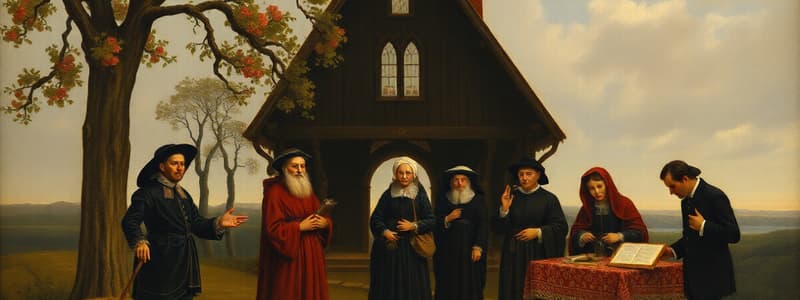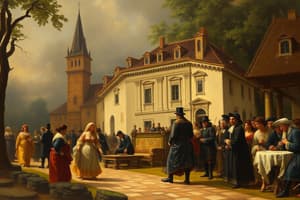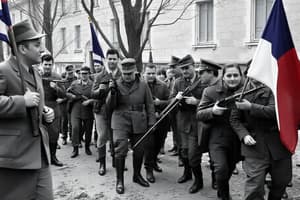Podcast
Questions and Answers
Which branch of Protestantism originated in England?
Which branch of Protestantism originated in England?
- Anabaptist
- Reformed
- Anglican (correct)
- Lutheran
What significant event happened on August 24, 1572, regarding the Huguenots?
What significant event happened on August 24, 1572, regarding the Huguenots?
- They established their first synod
- A massacre occurred (correct)
- Calvin wrote the first edition of the Institutes
- A major treaty was signed
Which figure introduced Lutheran ideas to Scotland and was executed in 1528?
Which figure introduced Lutheran ideas to Scotland and was executed in 1528?
- John Knox
- George Wishart
- Patrick Hamilton (correct)
- Henry IV
What was the significance of the Edict of Nantes in 1598?
What was the significance of the Edict of Nantes in 1598?
What major change occurred in Scotland in 1560 regarding its church structure?
What major change occurred in Scotland in 1560 regarding its church structure?
What factor characterized the English Reformation under Henry VIII?
What factor characterized the English Reformation under Henry VIII?
What was the fate of many during Henry VIII's reign in terms of religious persecution?
What was the fate of many during Henry VIII's reign in terms of religious persecution?
Which of these figures is known for promoting Protestant ideas in France?
Which of these figures is known for promoting Protestant ideas in France?
What significant role did Thomas Cranmer play in the English Reformation?
What significant role did Thomas Cranmer play in the English Reformation?
How did Cranmer respond during his execution?
How did Cranmer respond during his execution?
Which action did Mary Tudor take during her reign?
Which action did Mary Tudor take during her reign?
What was Elizabeth I's title as stated in the Act of Supremacy?
What was Elizabeth I's title as stated in the Act of Supremacy?
What was one of the consequences of Elizabeth I's religious policies?
What was one of the consequences of Elizabeth I's religious policies?
What was a major factor in Mary's desire to restore Catholicism?
What was a major factor in Mary's desire to restore Catholicism?
What was the fate of Lady Jane Grey during Mary Tudor's reign?
What was the fate of Lady Jane Grey during Mary Tudor's reign?
What significant military event occurred during Elizabeth I's reign?
What significant military event occurred during Elizabeth I's reign?
Which group was Cranmer part of that promoted the English Reformation?
Which group was Cranmer part of that promoted the English Reformation?
What characterized Elizabeth I's relationship with her subjects?
What characterized Elizabeth I's relationship with her subjects?
What title was given to Henry VIII by Pope Leo for his defense of the seven sacraments?
What title was given to Henry VIII by Pope Leo for his defense of the seven sacraments?
Which of Henry VIII's wives was executed for adultery?
Which of Henry VIII's wives was executed for adultery?
What significant action did England take in 1534 regarding the church?
What significant action did England take in 1534 regarding the church?
Which reform was introduced during Edward VI's reign?
Which reform was introduced during Edward VI's reign?
Who were the three famous martyrs during Mary Tudor's reign?
Who were the three famous martyrs during Mary Tudor's reign?
Why did Henry VIII seek an annulment of his marriage to Catherine of Aragon?
Why did Henry VIII seek an annulment of his marriage to Catherine of Aragon?
What was the result of the Act of Supremacy in 1534?
What was the result of the Act of Supremacy in 1534?
What significant change to worship services was made under Edward VI?
What significant change to worship services was made under Edward VI?
What happened to Thomas More after he refused to accept Henry's title as head of the Church?
What happened to Thomas More after he refused to accept Henry's title as head of the Church?
During Mary's reign, what religious practice was restored to its former state?
During Mary's reign, what religious practice was restored to its former state?
How did Mary Tudor's actions contribute to her nickname 'Bloody Mary'?
How did Mary Tudor's actions contribute to her nickname 'Bloody Mary'?
What was the purpose of the Great Bible, also known as the Chained Bible?
What was the purpose of the Great Bible, also known as the Chained Bible?
What was said by Latimer regarding the sufficiency of Christ's sacrifice?
What was said by Latimer regarding the sufficiency of Christ's sacrifice?
What major decision did Parliament make concerning monasteries in 1536 and 1539?
What major decision did Parliament make concerning monasteries in 1536 and 1539?
Flashcards are hidden until you start studying
Study Notes
France and the Reformation
- Lutheran ideas reached France in the early 16th century.
- John Calvin and others promoted Protestant ideas.
- King Francis I suppressed Lutheran ideas.
- Calvin was arrested but escaped and fled to Switzerland.
- Calvin wrote the first edition of the Institutes in 1536 to defend French Protestants.
- French Protestants organized into a synod by 1559.
- French Protestants were known as Huguenots from 1560 onward.
- The St. Bartholomew's Day Massacre in 1572 resulted in the deaths of thousands of Huguenots over two days.
- Henry of Navarre, a Huguenot leader, converted to Roman Catholicism in 1593 and ruled as Henry IV.
- The Edict of Nantes (1598) granted Huguenots religious tolerance as a minority.
- Louis XIV revoked the Edict of Nantes in 1685, leading to Huguenots fleeing to other countries.
The Reformation in Scotland
- Scotland aligned with France in the 14th century to resist English influence.
- The Roman Catholic Church was deemed immoral and corrupt.
- Patrick Hamilton introduced Lutheran ideas and was burned at the stake in 1528, followed by George Wishart in 1546.
- Wishart influenced John Knox, who later traveled to Geneva and was greatly influenced by John Calvin.
- Knox returned to Scotland in 1559, coinciding with Scottish nobles' covenanting for religious reform, leading to the end of French control over Scotland.
- The Scottish Parliament, under John Knox's guidance, initiated religious reform in 1560.
- The Church of Scotland was formally established in 1567, featuring presbyteries, synods, and a national assembly.
- Papal control was lost, the Mass was outlawed, and laws against heretics were repealed.
The English Reformation
- Key players in the English Reformation included:
- Monarchs: Henry VIII, Edward VI, Mary Tudor (Bloody Mary), Elizabeth I
- Parliament
- Lollards (followers of Wycliffe)
- Humanists (Erasmus, Colet)
- The Reformation in England was marked by:
- Changes dependent on the ruler’s preferences.
- Fluctuations in progress.
- Numerous martyrs, with estimates of 70,000 deaths during Henry VIII's reign and 300 during Mary Tudor's reign.
- Theological statements by the Church backed by the government.
- Bible translations into common language.
- A stronger emphasis on political than theological elements.
Henry VIII (1491-1547)
- Henry VIII was known for his wide-ranging skills as a scholar, hunter, and sportsman.
- He initially defended the seven sacraments of the Roman Catholic Church, earning the title "Defender of the Faith" from Pope Leo.
- Henry married Catherine of Aragon, his brother's widow, to maintain England's relationship with Spain.
- Canon law prohibited marriage to one's brother's wife, but a special papal approval was granted due to Catherine's claim that her marriage to Arthur was not consummated.
- Catherine had difficulty bearing children and only had one surviving daughter, Mary.
- Seeking a male heir, Henry sought an annulment of his marriage, arguing that it was against canon law.
- The Pope refused as Catherine was the aunt of Emperor Charles V, who controlled Europe and the Papacy.
- Henry considered having a secret affair and an illegitimate male child but wanted a legitimate heir.
- Thomas Cranmer, advisor to Henry VIII, declared the marriage with Catherine invalid after consulting with scholars.
- England broke with Rome in 1534.
England's Break with Rome
- Parliament enacted laws prohibiting money transfers to Rome, invalidating Henry's marriage, and declaring him the "supreme Head of the Church of England."
- Thomas More, Henry's close friend and Chancellor of England, refused to recognize Henry's title as head of the Church.
- More was executed, famously stating, "The King's good servant, but God's first."
- Henry married Anne Boleyn, a mistress, who bore him Elizabeth. Anne was accused of adultery and executed.
- Henry then married Jane Seymour, who gave birth to Edward (VI).
- After Seymour's death, Henry married Anne of Cleves from Protestant Germany, seeking German support against Rome.
- He later divorced Anne of Cleves and executed the person who arranged the marriage due to lessening threats from other nations and Germany's focus on doctrine.
- Henry then married Catherine Howard, who was also beheaded.
- He finally married Catherine Parr, who outlived him.
Changes during the English Reformation (1529-1539)
- English clergy were required to remain in England.
- Appeals of English Church matters to the Papal courts in Rome were prohibited.
- The Act of Supremacy (1534) was introduced, declaring Henry the "supreme head of the Church of England."
- Monasteries with incomes less than 200 pounds were closed in 1536, and their property was seized by the King.
- In 1539, larger monasteries were closed by Act of Parliament. The King retained some land and sold or gave the rest to wealthy families, ensuring their support.
- Although the Anglican Church remained doctrinally Catholic, Henry authorized the translation of the Bible into English (a revision of Tyndale and Coverdale).
- This translation was known as the Great Bible or the Chained Bible due to being chained to stands in churches.
Edward VI (1537-1553)
- Edward VI became King at the age of nine.
- His mother's brother, the Duke of Somerset, was appointed regent.
- The Duke promoted Protestant ideas and influenced Edward to introduce reforms.
- Changes made included:
- Switching worship services from Latin to English.
- Establishing the 42 Articles, the Anglican creed, by Thomas Cranmer, Archbishop of Canterbury.
- Allowing laity to take the cup in the Holy Communion.
- Granting clergy the right to marry.
- Banning images in churches.
- Creating the Book of Common Prayer, largely written by Cranmer, for public worship.
Mary Tudor (1516-1558)
- Mary Tudor (Bloody Mary) became Queen upon Edward VI's death.
- She sought to restore Roman Catholicism to England.
- Her marriage to Phillip of Spain was unhappy, and she had no children.
- Mary's persecution of Protestants earned her the title "Bloody Mary."
- She reintroduced clerical celibacy and other Catholic practices.
- Many clergymen lost their positions and became martyrs.
- Mary was said to be an unhappy person yearning for love.
- She was secluded for extended periods due to the annulment of her mother's marriage.
- Her strong desire to reinstate Catholicism stemmed from the threat that Protestantism would render her illegitimate.
- Elizabeth I became queen upon Mary's death due to illness.
Thomas Cranmer (1489-1556)
- Cranmer was part of a group at Cambridge University interested in Luther's reforms.
- This group, dubbed "Little Germany," included William Tyndale, Robert Barnes, and Thomas Bilney, all figures in the English Reformation.
- Cranmer became an advisor to Henry VIII and later to Edward VI.
- He was respected by Henry but ultimately did as the King wished.
- Cranmer pleaded for those condemned by Henry, including Anne Boleyn and Thomas More.
- He was a key architect of the English Reformation, known for drafting the 42 Articles and the Book of Common Prayer.
- He implemented significant reforms under Edward VI, replacing the Catholic concept of transubstantiation with consubstantiation.
- He believed Christ was truly present in the Eucharist but differed from Luther's view.
- The English Reformation stalled after Edward's death, with Mary Tudor restoring Roman Catholicism.
- Cranmer witnessed Ridley and Latimer's execution in Oxford.
- He signed several recantations after being tempted with freedom but regained his courage in the face of death.
- Cranmer surprised everyone by refusing to recant his beliefs, denying Papal authority, and asserting that transubstantiation was false.
- He held his right hand, which had signed false declarations, into the flames until it was consumed during his execution.
- Cranmer is considered a leader of the true English Reformation.
Elizabeth I (1533-1603)
- Elizabeth I was born to Henry VIII and Anne Boleyn.
- Her mother was beheaded for adultery when she (Elizabeth) was two.
- She received a quality education from Catherine Parr, Henry’s sixth wife.
- She became Queen after Mary Tudor’s death in 1558.
- Her 45-year reign is considered a golden age of English history.
- She was known for her wisdom, intelligence, and fluency in six languages.
- Elizabeth returned England to the Protestant faith.
- The Act of Supremacy (1559) declared her the "only supreme governor" in spiritual and temporal matters.
- She was excommunicated by the Pope in 1570.
- She worked closely with loyal administrators to establish control.
- She was close to her people and traveled on horseback 25 times around the country to connect with them.
- She executed her Catholic cousin, Mary, Queen of Scots, in 1587 after 19 years, when it was clear she was plotting her overthrow.
- In 1588, Philip II of Spain organized the Spanish Armada to combat England.
- Backed by the Pope, Philip aimed to restore Catholicism in England.
- She rallied her soldiers with speeches like, “I know I have the body of a weak, feeble woman; but I have the heart and stomach of a king - and of a King of England too."
- Despite Spain’s larger navy, England defeated the Armada.
- Elizabeth remained unmarried and died in 1603, succeeded by Mary Queen of Scots’ son, James I (England)/VI (Scotland).
Studying That Suits You
Use AI to generate personalized quizzes and flashcards to suit your learning preferences.




